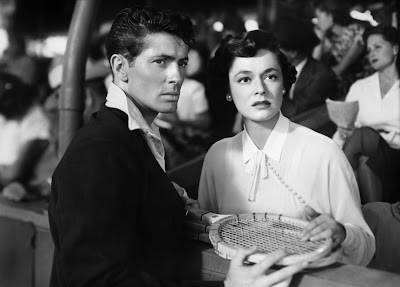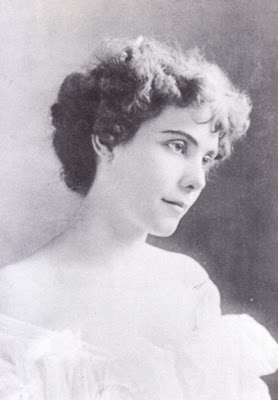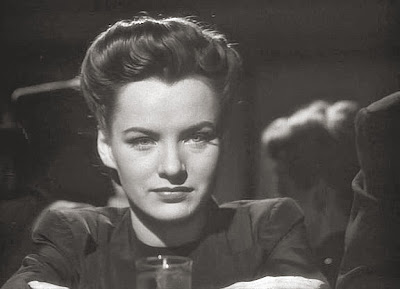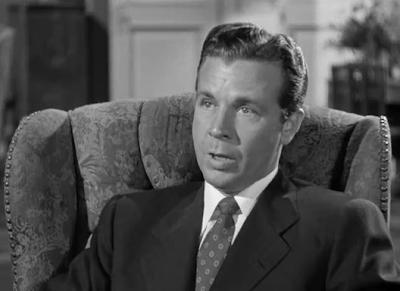
Yesterday was Raymond Chandler's Anniversary (1888-1959). When Raymond Chandler died on 26 March 1959, The Times declared in his obituary that ‘in working the common vein of crime fiction, he mined the gold of literature’. John Sutherland, emeritus professor of Modern English Literature at University College London, said: ‘Raymond Chandler qualifies as the Marcel Proust of the hard-boiled detective novel. For Chandler literary style was all that mattered.’ His most famous creation was the private detective Philip Marlowe: "Of course Marlowe is a failure and he knows it", Chandler explained, "But you must remember that Marlowe is a creature of fantasy. Your private detective in real life is usually an ex-policeman with a lot of hard practical experience who runs around trying to find out where people have moved to".
Some of my favourite impersonations of Philip Marlowe in the cinema (Dick Powell was the first Marlowe and the closest to the novel's character in a risky choice of his career, Bogart's cynic detective is the most iconic, Montgomery's Marlowe was more a mysterious presence and Mitchum fit Marlowe like a glove around a decadent European neo-noir scenario):
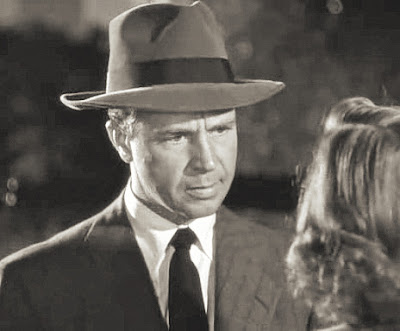 Dick Powell as Philip Marlowe in "Murder, My Sweet" (1944) directed by Edward Dmytryk
Dick Powell as Philip Marlowe in "Murder, My Sweet" (1944) directed by Edward Dmytryk Humphrey Bogart as Philip Marlowe in "The Big Sleep" (1946) directed by Howard Hawks
Humphrey Bogart as Philip Marlowe in "The Big Sleep" (1946) directed by Howard Hawks Robert Montgomery as Philip Marlowe in "Lady in the Lake" (1947)
Robert Montgomery as Philip Marlowe in "Lady in the Lake" (1947) Robert Mitchum as Philip Marlowe in "Farewell, My Lovely" (1975) directed by Dick Richards
Robert Mitchum as Philip Marlowe in "Farewell, My Lovely" (1975) directed by Dick Richards
"A new biography about Raymond Chandler has been released on July 16 by Aurum Press Ltd, written by Tom Williams: "What we know of Raymond Chandler is shrouded in secrets and half-truths as impenetrable and deceptive as anything in his magisterial novel, The Long Goodbye. Now, drawing on new interviews, previously unpublished letters and archives on both sides of the Atlantic, literary gumshoe Tom Williams casts light on this most mysterious of writers. The Raymond Chandler revealed is a man troubled by loneliness and desertion from an early age – experiences that fuelled his writing as much as they scarred his life." Source: www.aurumpress.co.uk

Raymond Chandler was otherwise described, in the course of his life, as cynical and gullible; reclusive and generous; depressive and romantic; proud and paranoid. Two things stabilized him. Being drunk, which he often was, and Philip Marlowe. Chandler tried different types of writing, but he always returned to detective fiction and to Marlowe. ‘I simply cannot operate without him,’ he eventually decided. Described by Evelyn Waugh in the late 1940s as no less than ‘the greatest living American novelist’, he was admired by the likes of T. S. Eliot, W. H. Auden and Edmund Wilson. Chandler picked up several prizes towards the end of his time at Dulwich. He was outstanding at mathematics. (This was a proficiency Chandler shared with the two other most famous crime writers of his generation: Georges Simenon and Dashiell Hammett.) On the basis of his short apprenticeship at the Admiralty and his proficiency at mathematics, Chandler decided on accountancy.

Of his hero, Chandler wrote a month before his death that he always saw him ‘in a lonely street, in lonely rooms, puzzled but never quite defeated’. Like Marlowe, Chandler in 1913 was intelligent but without immediate prospects. In the four-year gap between Cissy Pascal’s divorce and Florence Chandler’s death, Chandler supported the two women in different houses in Los Angeles. Both lived in cheap apartments in mixed neighbourhoods south of the city: Cissy on Hermosa Beach; Florence in South Catalina Street on Redondo Beach.
 Southern California had special reasons to anticipate prosperity: oil and land. Chandler was fascinated by the new corporate giants like Du Pont, Alco and Standard Oil.
Southern California had special reasons to anticipate prosperity: oil and land. Chandler was fascinated by the new corporate giants like Du Pont, Alco and Standard Oil.
Chandler experienced blackouts, or alcohol-induced amnesia, when he drank heavily. There would be an intense blackout scene involving amnesia and usually alcohol in every one of Chandler’s Marlowe novels, as well as in one of his Hollywood screenplays. In fact, the blackout scene became a distinct trademark of Marlowe’s adventures. These scenes were given such prominence and space throughout Chandler’s writing that they beg at least two clear biographical correlations. First, the German bombardment that left Chandler unconscious during the First World War and ended his infantry career. Second, the blackouts that he experienced when he drank heavily; specifically, the sustained binge he embarked on at Dabney’s.
Cissy had kept her model’s figure and, according to Chandler’s colleagues at Dabney’s, had the sexual presence of a thirty-year-old. For each wedding anniversary, Chandler would fill the house with red roses and the two of them would drink champagne. Cissy called Chandler ‘Raymio’ because he was so romantic and she was a good foil to his erratic daydreams. Cissy had no money of her own and he had successfully insulted most of the friends who might previously have helped. "There is nothing like losing your money," Chandler later said, "in order to see who your friends are". And by 1932, at the age of forty-four, Chandler had none. He and Cissy would have to move out of central Los Angeles to the cheaper rents of Santa Monica, but for the time being they could survive on what they had while he tried to earn money by writing fiction ("I spent five months over a 18,000 word novelette and sold it for $180.")
Black Mask was a pulp magazine which had been set up by two New York editors in 1920 to support the lossmaking but prestigious literary magazine Smart Set. The connection with Smart Set – whose most famous contributor was F. Scott Fitzgerald – was an ironic one for Chandler. What was even more inspiring for Chandler was that, despite his respect for Dashiell Hammett (he met him once at a Black Mask dinner in LA), he did not consider Hammett to be an especially good writer: ‘What he did he did superbly,’ decided Chandler, ‘but there was a lot he could not do.’ While Chandler started work on his second Black Mask story in 1933, he and Cissy continued to exhaust his savings. Chandler, who had been earning almost $3,000 a month before he left Dabney’s, hated not having money and felt no sense of dignified poverty about his situation. He disagreed entirely with the idea that struggling writers were more creative the closer they were to the breadline. He and Cissy were almost on that now, and he hated it. ‘I never slept in the park,’ he said, ‘but I came damn close to it… it didn’t kill me, but neither did it increase my love of humanity.’ Self-deprivation was almost natural to a man who had just painfully forced himself out of a drink addiction. There was, however, the guilt of not being able to look after Cissy properly, as well as the guilt of having brought such a situation upon himself.
"The Smell of Fear" was the name Chandler would later give to an anthology of his pulp stories. In an introduction to the book, he put Black Mask stories within the context of this permanent edginess: "Their characters lived in a world gone wrong, a world in which, long before the atom bomb, civilization had created the machinery for its own destruction. The streets were dark with something more than night." While achieving growing recognition and earning larger fees – though still never more than $350 – for his Black Mask stories, Chandler continued to live in low-rent Santa Monica. Even writing five stories a year, as he did in 1936, only earned him $1,500. In contrast to the grandeur of nearby Beverly Hills, Santa Monica contained thousands of small wooden houses on near-identical streets that were spread either side of Pico Boulevard.
Dime Detective paid Chandler $400 per story, but that was not enough to enable him and Cissy to move out of the Santa Monica apartment. The break came in 1938, when a New York literary agent called Sydney Sanders showed some of Chandler’s pulp stories to the publisher Alfred Knopf. Knopf was impressed, and told Chandler that he would be interested in seeing a novel. He had promptly become the best pulp writer in America. But he had done so at a cost: for five years he and Cissy had cut themselves off from the world while he wrote, and this seclusion had hurt him. His complexion had paled, he suffered from rheumatism in his right arm, and he had become almost totally reclusive. ‘Most writers,’ he later said, ‘sacrifice too much humanity for too little art.’
"The Big Sleep" was written in Chandler’s Santa Monica apartment over the summer of 1938. Named after Marlowe House at Dulwich College, the novel’s narrator and hero was thirty years old and single: ‘I’m unmarried because policemen’s wives don't like me.’ It was soon obvious that Marlowe was no ordinary pulp private detective. He played chess by himself, and often felt paranoid: "My mind drifted through waves of false memory, in which I seemed to do the same thing over and over again, go to the same places, meet the same people, say the same words to them, over and over again, and yet each time it seemed real, like something actually happening, and for the first time."
"Marlowe was an idealist," said Chandler, ‘he hates to admit it, even to himself.’ Here was a tough, independent character with an acute and almost constant sense of life’s absurdity. To end a murder story questioning the significance of death was a new departure for a crime writer. The suspense was still there, but it was there as atmosphere rather than in hidden clues. Not even Hammett had risked going this far with his detectives; nor had Hammett developed the vision of crime fiction that Chandler was now developing. The character of Philip Marlowe was therefore a way in which Chandler might explain his own eccentric reclusivity. The book itself sold 18,000 copies – including British sales – which grossed Chandler only $2,000. Compared to Hammett and Cain, this was negligible. The former’s 1932 novel "The Thin Man" had sold 20,000 copies in America in its first three weeks, and MGM had bought the film rights for $21,000.
The money he had earned from "The Big Sleep" meant that he and Cissy could leave the cramped apartment they had been in for the last five years. Their departure did not, however, break the spell of their self-containment, and for the next five years, they lived in a series of coastal towns, LA suburbs and budget Californian holiday resorts. They continued to see almost no one except each other. When they left Santa Monica in 1939, Cissy was approaching seventy and had been badly weakened by her bouts of pneumonia. She had ‘not particularly liked’ The Big Sleep. Chandler received letters of encouragement from John Steinbeck and S. J. Perelman, both of whom had read The Big Sleep. He had been warned by other pulp writers about the critics.
"Farewell, My Lovely" was published in May 1940, but was again ignored by the critics. Despite an unusually large advertising budget from Knopf, it was not reviewed and sold worse than "The Big Sleep" (11,000 copies in America and 4,000 in Britain). Chandler could not relate to the revitalized Los Angeles. He saw a mass-produced culture emerging around the city; a corporation-sponsored ‘culture of the filtered cigarette’, where people were turning generic in their tastes and simple in their ambitions. "The Lady in the Lake" (1943) continued to show Marlowe’s frustration. Nothing makes him happy, all is phoney, and ‘everything’s for sale in California’. The novel shows Chandler and Marlowe at their most misanthropic. Of all the towns that he and Cissy flitted between, Big Bear Lake was still Chandler’s favourite.
Poster of Audrey Totter & Robert Montgomery in "Lady in the Lake" (1947) directed by Robert Montgomery
Shortly before "The Lady in the Lake" was published in 1943, a 25-cent edition of "The Big Sleep" appeared in America for the first time. Convinced that Chandler was never going to be recognized by the critics, Knopf had finally sold the pulp rights to the first novel to Avon. It immediately sold 300,000 copies, and a further 150,000 copies were sold in a special armed services edition. On the back of this success, Knopf allowed Pocket Books to publish a 25-cent edition of "Farewell, My Lovely" four months later. The book sold more than a million copies. As a result of this exposure, more hardback copies of "The Lady in the Lake" were sold in America than any of the other Marlowes, and although 14,000 was still not an enormous number, it earned the author $3,500. It was all slowly starting to happen – paradoxically, just as Chandler was starting to get bored with his writing.
[While working on "Double Indemnity" with Billy Wilder] he and Cissy moved into a small house at 1040 Havenhurst Drive, off Sunset Boulevard in West Hollywood. It was just five minutes from the Paramount lot. Years after the project, Wilder would describe Chandler as ‘one of the greatest creative minds I’ve ever encountered’, as well as ‘a naive, sweet, warm man’. He also said that the crime writer gave him ‘more trouble than any other writer I ever worked with.’ Chandler and Cissy had now moved to Drexel Avenue, further to the south of Hollywood, off La Cienega. Producers, Chandler found, were generally ‘low-grade individuals with the morals of a goat and the artistic integrity of a slot machine.’
Humphrey Bogart as Philip Marlowe in the “Big Sleep” (1946)
The year that Chandler left Hollywood was, paradoxically, capped by his greatest triumph of all. The release of "The Big Sleep" in 1946, starring Humphrey Bogart and directed by Howard Hawks, propelled both Chandler and Marlowe into the realms of international stardom.

Bogart felt a bond with this character who, having little time for food, managed to exist through lunchless dinners and dinnerless days with the aid of a bottle of bourbon. ‘Why doesn’t he go overboard for a girl?’ he asked Chandler. ‘Marlowe would lose something by being promiscuous,’ said Chandler. ‘I know he can’t go on forever saying no the way he does – the guy’s human – he’ll have to break sometime but I’ve never wanted the sex bit to dominate either him or the story.’ Chandler would remain grudgingly fascinated by Hollywood even after he had left Los Angeles. Chandler bought a $3,000 Steinway piano for Cissy, though at seventy-six she was getting too old to play for long; when she did, she played Chopin. She had her own bedroom now; the most elegant room in the house, with chaises longues and elaborate French lamps, and there she kept the platinum and gold jewellery that Chandler had bought her with his Hollywood money.
Chandler said that he thought American critics were suffering from ‘pseudoliterate pretentiousness.’ Intellectuals had no dreams left to offer people, he said, and were embarrassed by any emotion other than disappointment: "An age which is incapable of poetry is incapable of any kind of literature except that cleverness of a decadence". Of Graham Greene’s "The Heart of the Matter", Chandler remarked that it had everything that made a good book ‘except verve, wit, gusto, music and magic’. Eugene O’Neill was ‘utterly artificial’; Auden ‘leaves me groping’; Osbert Sitwell was ‘an Edwardian who stayed up too late’; and the critics who fawned around T. S. Eliot were sterile neurotics looking for ‘stale cake’ to ‘wrap up in a fancy name and sell to the snob-fakers’. Chandler believed that the entire intellectual establishment was in a state of terminal self-delusion, cut off from the public it despised. Such people thought they could write, he said, ‘because they have read all the books’, but they were in fact hacks. ‘There is more life in the worst chapter Dickens or Thackeray ever wrote, and they wrote some pretty awful ones’.
Farley Granger and Ruth Roman in "Strangers on a Train" (1951) directed by Alfred Hitchcok (screenplay by Raymond Chandler)
"Alfred Hitchcock never forgave Chandler for calling him a ‘fat bastard’ yet Chandler seemed impervious to the fact they were no longer friends. When he died in a La Jolla Hospital in March 1959, the official cause of death was pneumonia, but in truth he had been almost constantly drunk since Cissy had died. It was simply too much for his body to bear. His funeral was attended by only 17 people, a sad but in some ways appropriate end for a man who had never gone out of his way to make friends." Source: www.dailymail.co.uk
Chandler thought Communism was just a ‘fashion’ in America and ‘just as corrupt as Catholicism underneath.’ Suspicious as he was of most institutions, Chandler was politically non-partisan. He disliked the Church, but he also thought that scientists were held in too much awe: ‘they are the sacred cows of our times’. In defence of murder fiction, Chandler told his correspondents that few people seemed to realize that most of the world’s surviving literature has been concerned with violent death, rather than ‘drawing room neuroses or threadbare intellectualism’.
The trouble was, he believed, that post-war Western culture was being controlled by the first generation of highbrows not to have a grounding in the classics. Without God and without heroes, it was a generation that admired the art of writing itself rather than writing about things that meant anything. Nervous fashion had replaced wisdom. ‘The critics of today’, he told Charles Morton, ‘are tired Bostonians like Van Wyck Brooks or smart-alecks like Fadiman or honest men, confused by the futility of their job, like Edmund Wilson.’ They were all hooked on syntax and pessimism, ‘the opium of the middle classes’.
He had begun "The Little Sister" while at Paramount, but had kept having to stop work on it. It was set in Hollywood, and was threatening to confirm Chandler’s suspicion that it was almost impossible to write a good Hollywood novel because the whole place was itself already a kind of novel. The book was ambivalently reviewed in America on its publication in October 1949. Evelyn Waugh called Chandler ‘the best writer in America’.
“She was the beat of my heart for thirty years. She was the music I heard faintly at the edge of sound,” Chandler wrote at the time Cissy died.
After Cissy's death in 1954, Chandler’s return to full-scale drinking both emboldened and confused him in his search for someone to replace her: "I always opened the car door for her and helped her in. I never let her bring me anything. I always brought things to her. I never went out of a door or into before her. I never went into her bedroom without knocking. I suppose these are small things – like constantly sending her flowers, and always having seven presents for her birthday, and always having champagne on our anniversaries. They are small in a way, but women have to be treated with great tenderness and consideration – because they are women". (Chandler's letter to Deirdre Gartrell, 1957)
Chandler's taut flow of words transport us to a decaying and sometimes badly illuminated no-return world. Philip Marlowe, in his most 'private' moments, met shady characters at the most recondite locations in the South of California where he unravelled some dead-end mysteries. And in his most unexpected moments, the underpaid, callous, and principled detective mirrored the very chords that sustain our humanity, and what's more important than that? Chandler wanted Marlowe to be real, and to talk ‘with a rude wit, a lively sense of the grotesque, a disgust for sham, and a contempt for pettiness’. He had once been asked by a Canadian journalist whether he ever read his own fiction: "Yes, and at the very risk of being called an egotistical twerp, there must be some magic in the writing after all, but I take no credit for it. It just happens, like red hair." -"Raymond Chandler" by Tom Hiney (1999)
"I do a great deal of research, especially in the apartments of tall blondes. I get my material in various ways, but my favorite procedure consists of going through the desks of other writers after hours. I am thirty-eight years old and have been for the last twenty years. I do not regard myself as a dead shot, but I am a pretty dangerous man with a wet towel. But all in all I think my favourite weapon is a twenty dollar bill.” —Raymond Chandler, "Raymond Chandler Speaking" (1997)

Audrey Totter plays Adrienne Fromsett in "Lady in the Lake"
In my class of literature during my college years, we were assigned to read one crime detective novel and I chose "The Lady in the Lake", which is possibly my favorite novel by Raymond Chandler although it's not as highly regarded as "The Long Goodbye". I prefer "The Big Sleep", "Farewell, My Lovely" and even "The Little Sister" over "The Long Goodbye". I recently read about the Lago Retba (Lago Rosa/Pink Lake) on the Cap Vert, surrounded by a landscape of dunes and palmtrees, whose water's color changes due to a different salt concentration (caused by the Dunaliella salina bacteria) and the variable intensity of the sun's rays that altere the water's chromatism from pink to mauve. These changes reminded me of Chrystal Kingsley and Muriel Chess's changes of hair color. Lago Retba reminded me of Little Fawn Lake.
"She moistened her lips and held her head on one side, staring at me fixedly. There was a quiet little silence. The damp breath of the Pacific slid into the room around us." -"The Lady in the Lake" (1943) written by Raymond Chandler













